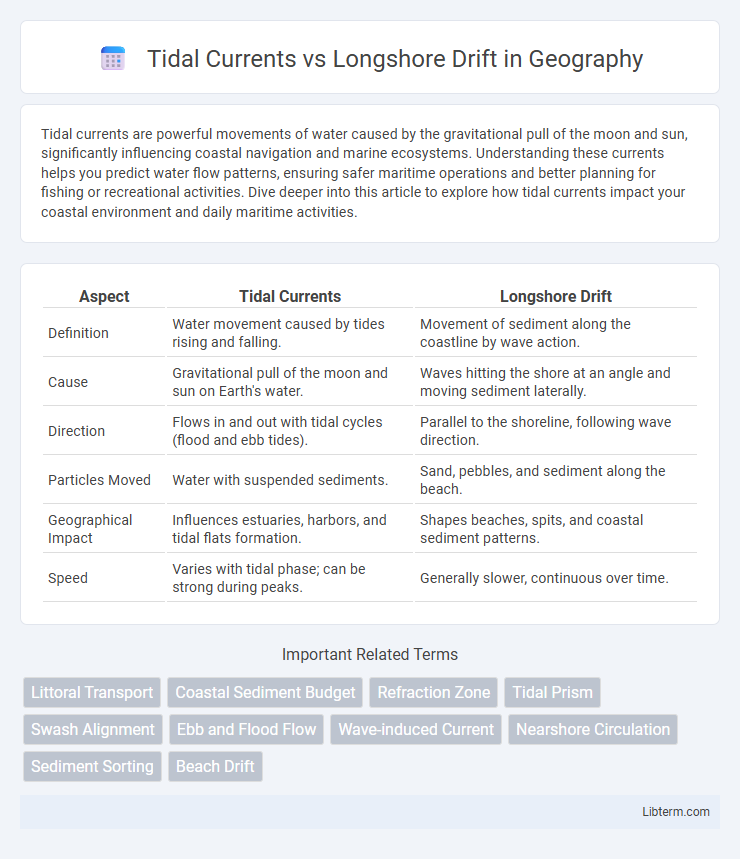Tidal currents are powerful movements of water caused by the gravitational pull of the moon and sun, significantly influencing coastal navigation and marine ecosystems. Understanding these currents helps you predict water flow patterns, ensuring safer maritime operations and better planning for fishing or recreational activities. Dive deeper into this article to explore how tidal currents impact your coastal environment and daily maritime activities.
Table of Comparison
| Aspect | Tidal Currents | Longshore Drift |
|---|---|---|
| Definition | Water movement caused by tides rising and falling. | Movement of sediment along the coastline by wave action. |
| Cause | Gravitational pull of the moon and sun on Earth's water. | Waves hitting the shore at an angle and moving sediment laterally. |
| Direction | Flows in and out with tidal cycles (flood and ebb tides). | Parallel to the shoreline, following wave direction. |
| Particles Moved | Water with suspended sediments. | Sand, pebbles, and sediment along the beach. |
| Geographical Impact | Influences estuaries, harbors, and tidal flats formation. | Shapes beaches, spits, and coastal sediment patterns. |
| Speed | Varies with tidal phase; can be strong during peaks. | Generally slower, continuous over time. |
Introduction to Coastal Water Movements
Tidal currents are the horizontal movement of water caused by the rise and fall of tides, typically flowing in and out of coastal areas with predictable patterns. Longshore drift involves the transportation of sediment along the shoreline due to wave action approaching at an angle, reshaping beaches and coastal landscapes. Both processes play crucial roles in coastal water movements, influencing erosion, sediment deposition, and the overall dynamic environment of shorelines.
What Are Tidal Currents?
Tidal currents are the horizontal movement of water caused by the rise and fall of tides, influenced primarily by the gravitational pull of the moon and sun. These powerful water flows can significantly affect coastal environments by redistributing sediments and shaping marine ecosystems. Unlike longshore drift, which moves sediment parallel to the shore due to wave action, tidal currents flow in and out of estuaries and bays, impacting navigation and sediment transportation in tidal zones.
Understanding Longshore Drift
Longshore drift is a coastal process where sediment moves along the shoreline due to wave action approaching at an angle, transporting sand and pebbles parallel to the beach. This sediment transport shapes beach morphology and influences coastal erosion and deposition patterns. Tidal currents differ by moving water masses vertically and horizontally due to gravitational forces, but longshore drift specifically impacts shoreline sediment distribution through wave-induced motion.
Key Differences Between Tidal Currents and Longshore Drift
Tidal currents are horizontal water movements caused by the gravitational pull of the moon and sun, resulting in predictable flows that change direction with the tides. Longshore drift, on the other hand, is the transportation of sediment along the coast by wave action hitting the shore at an angle, leading to the gradual movement of sand and pebbles parallel to the shoreline. While tidal currents influence large-scale water movement and navigation, longshore drift primarily affects coastal erosion and sediment deposition.
Causes and Driving Forces
Tidal currents arise from the gravitational pull of the moon and sun, causing the periodic rise and fall of sea levels that drive water movement in coastal areas. Longshore drift is driven by wave action approaching the shore at an angle, moving sediment parallel to the coastline through swash and backwash processes. The primary driving force behind tidal currents is celestial gravitational attraction, while longshore drift is powered by wind-generated waves and their interaction with the shoreline.
Impact on Coastal Geography
Tidal currents significantly influence coastal geography by reshaping shorelines through the regular rise and fall of sea levels, causing erosion and sediment redistribution in estuaries and tidal flats. Longshore drift contributes to the lateral movement of sediment along the coastline, forming features such as spits, bars, and barrier islands that extend or reshape beaches. Both processes critically affect sediment deposition patterns, coastal landform evolution, and habitat distribution in coastal environments.
Influence on Sediment Transport
Tidal currents strongly influence sediment transport by causing periodic water movement that redistributes sediments in estuaries and coastal areas, often creating complex deposition and erosion patterns. Longshore drift consistently transports sediments parallel to the shore due to wave action at an angle, shaping beaches and forming coastal features like spits and sandbars. Understanding the interaction between tidal currents and longshore drift is crucial for coastal management and erosion prevention.
Role in Coastal Erosion and Deposition
Tidal currents drive the regular movement of water in and out of coastal areas, significantly influencing sediment transport and shaping estuaries and tidal flats through erosion and deposition. Longshore drift moves sediments parallel to the shoreline by wave action, redistributing sand along beaches and forming coastal features like spits and barrier islands. Together, these processes play crucial roles in coastal erosion and deposition, with tidal currents controlling sediment dynamics in tidal zones and longshore drift shaping beach morphology and shoreline stability.
Human Interaction and Coastal Management
Tidal currents significantly influence human activities such as shipping, fishing, and coastal infrastructure development by affecting navigation routes and sediment transport patterns. Longshore drift plays a crucial role in shaping sandy beaches, impacting beach nourishment projects and requiring precise management to prevent erosion and property damage. Effective coastal management integrates monitoring of both tidal currents and longshore drift to implement sustainable solutions like groynes, breakwaters, and sediment replenishment, protecting human settlements and maintaining ecological balance.
Conclusion: Comparing Tidal Currents and Longshore Drift
Tidal currents and longshore drift both significantly influence coastal geomorphology but differ in their mechanisms and effects. Tidal currents result from the gravitational pull of the moon and sun, causing rhythmic water movement that shapes estuaries and tidal flats, while longshore drift is driven by wave action parallel to the shore, transporting sediment along coastlines and forming features like spits and barrier islands. Understanding these processes is crucial for effective coastal management and erosion mitigation strategies.
Tidal Currents Infographic

 libterm.com
libterm.com